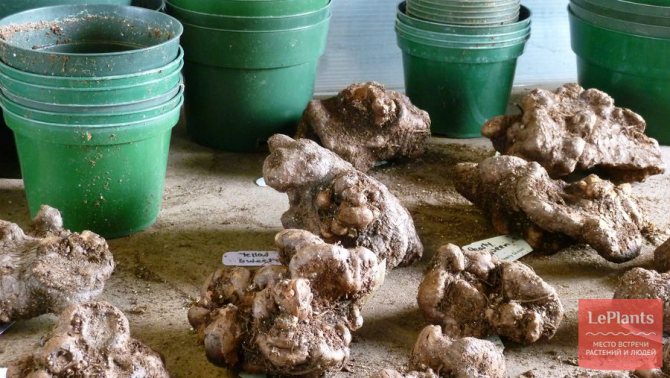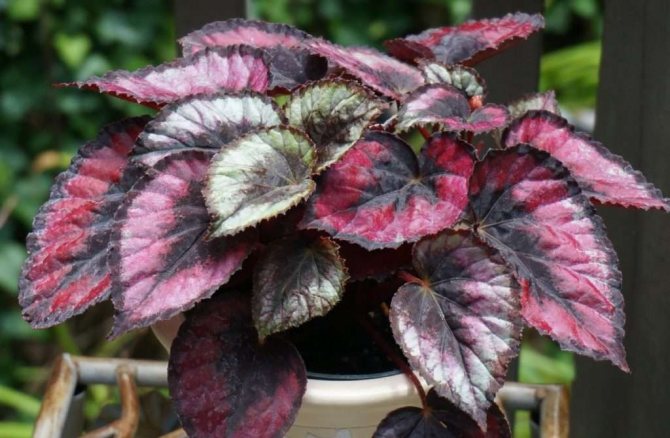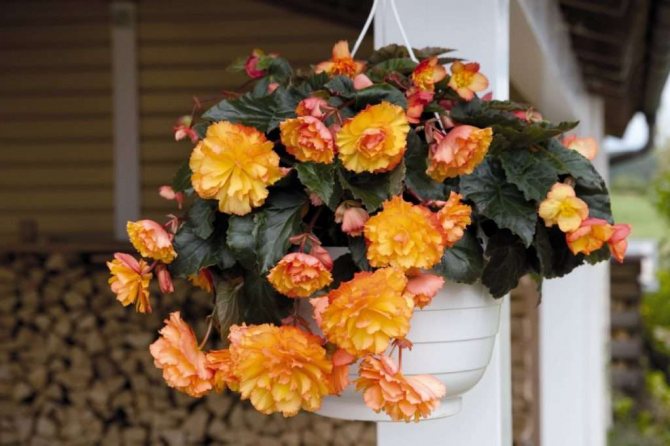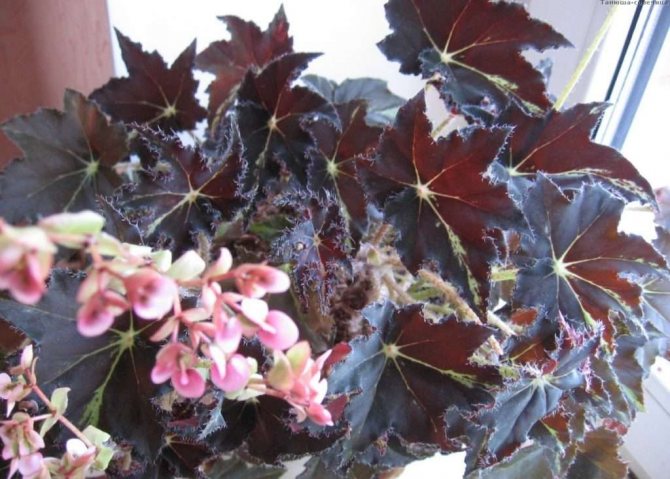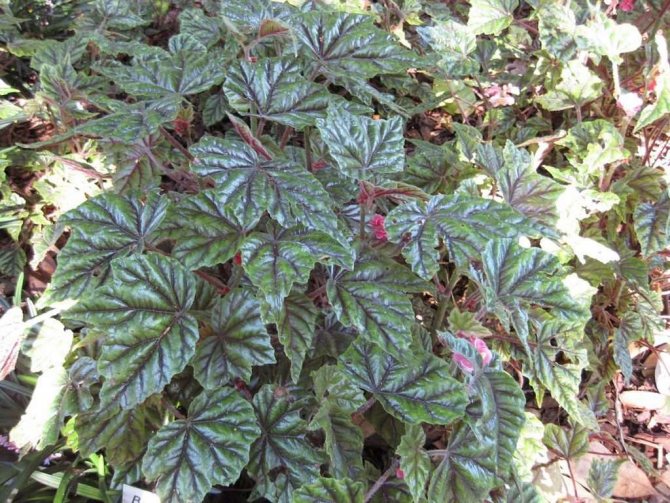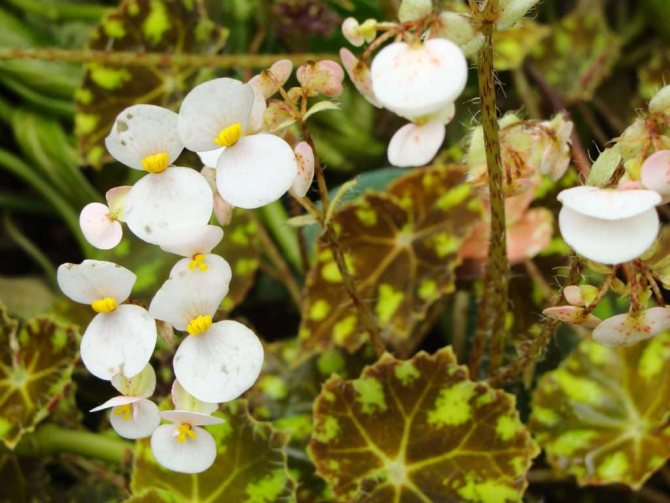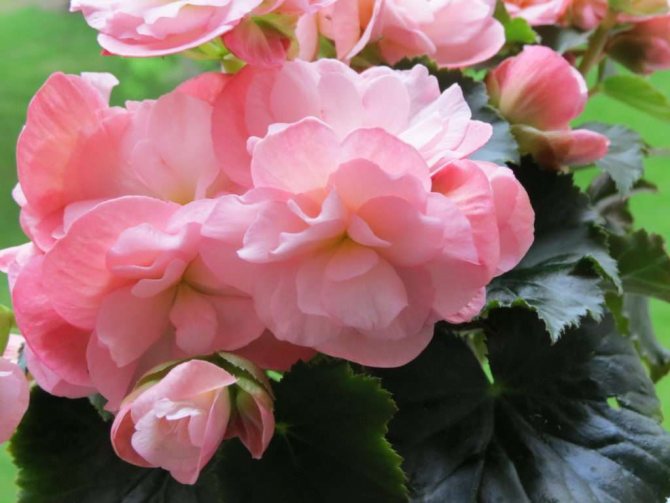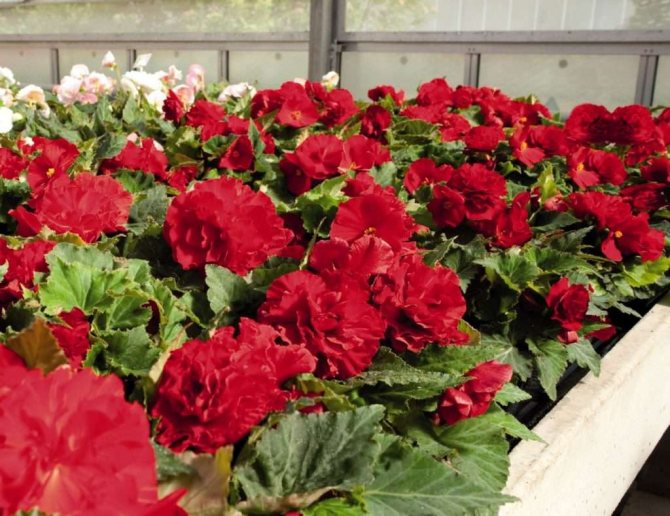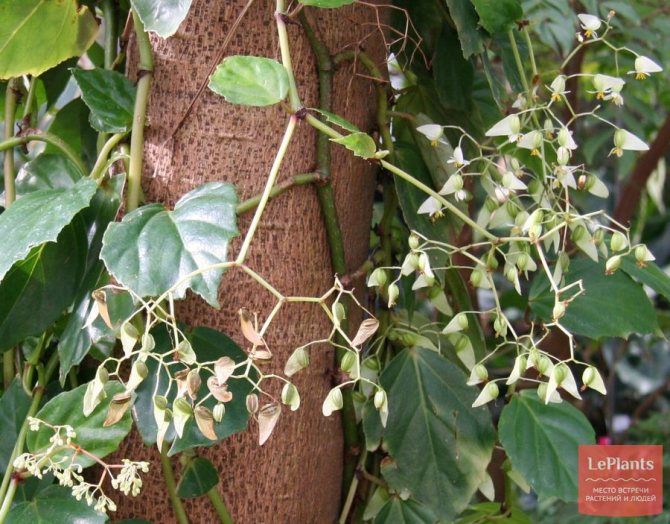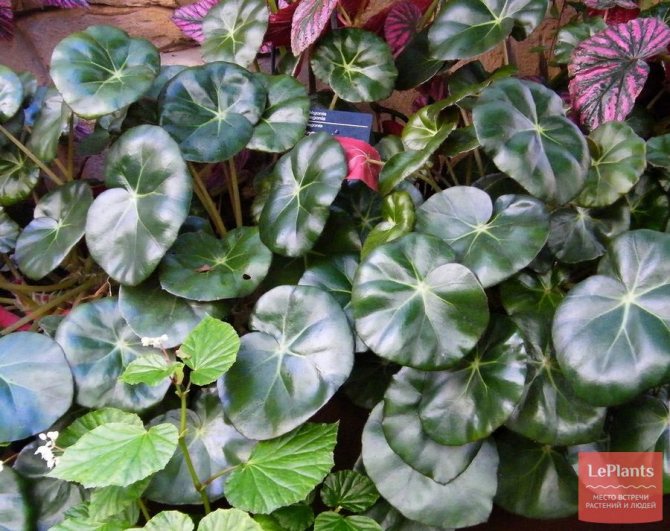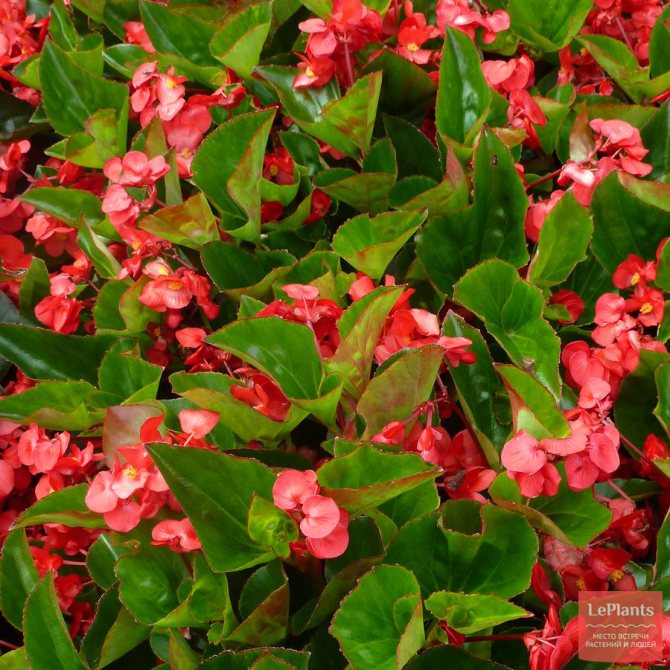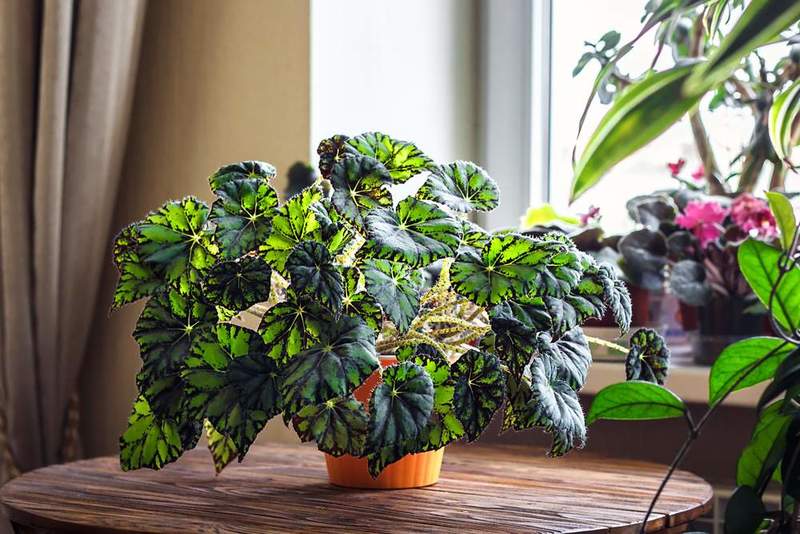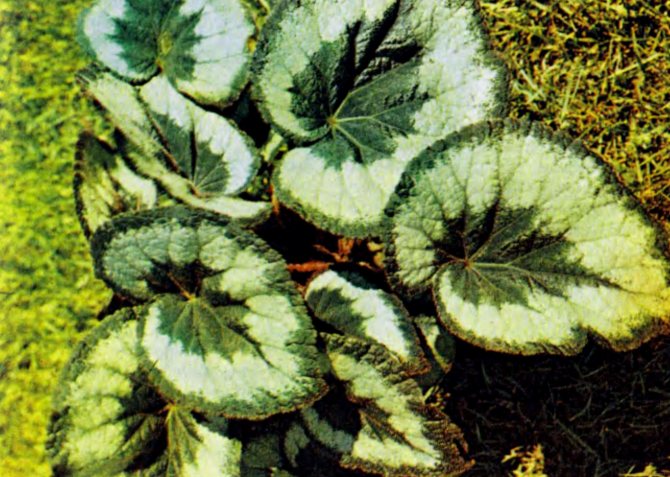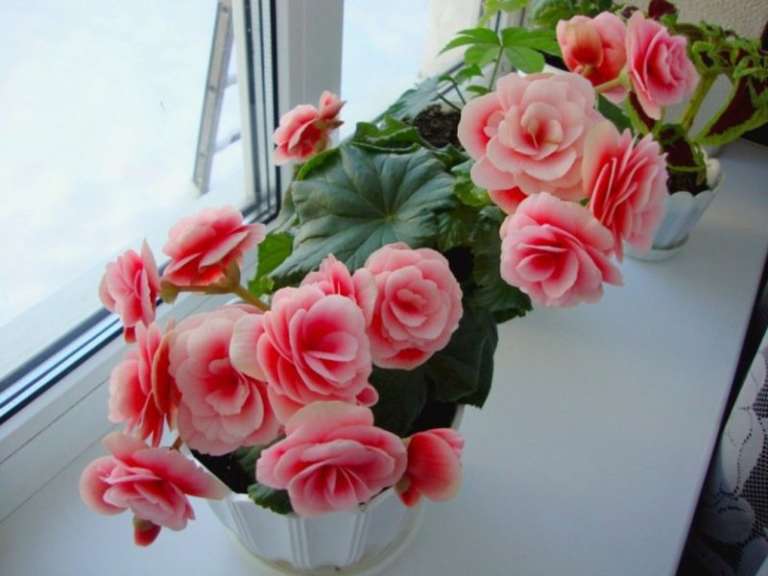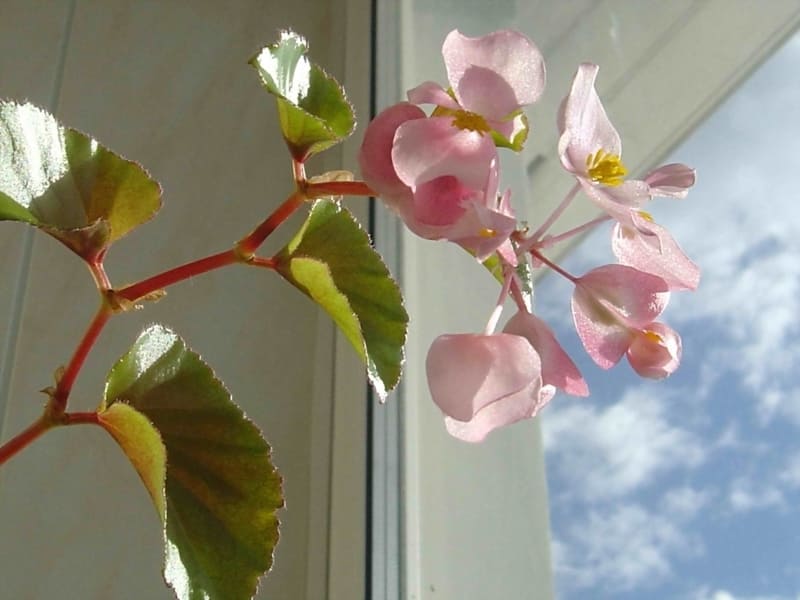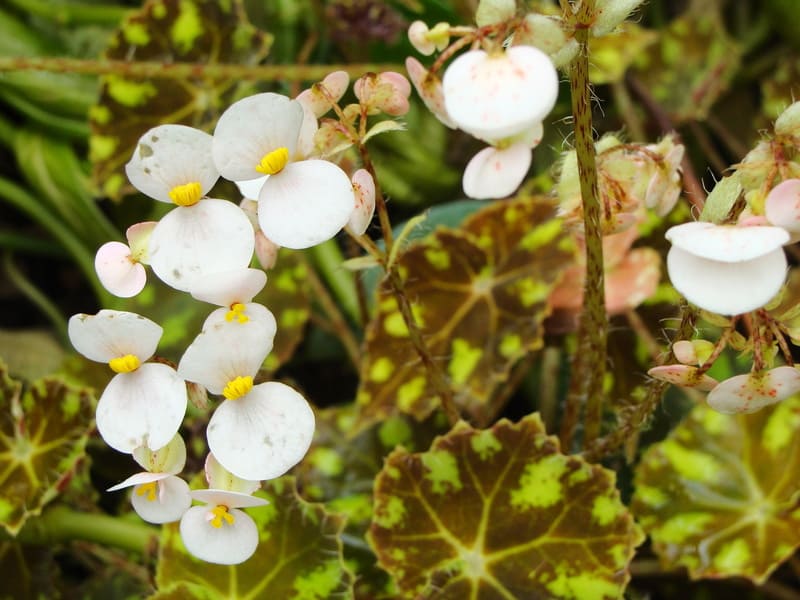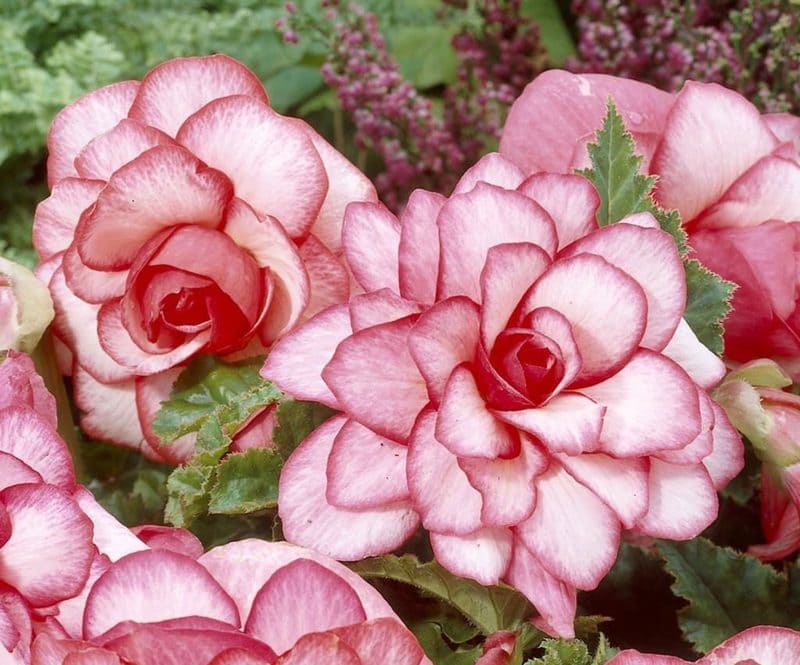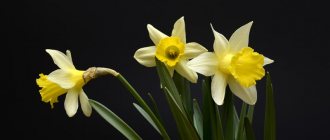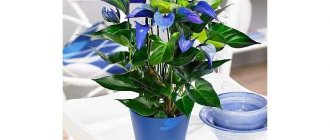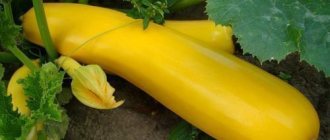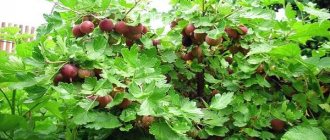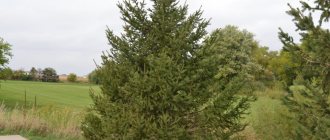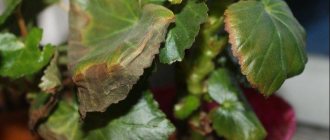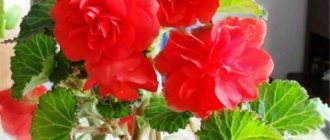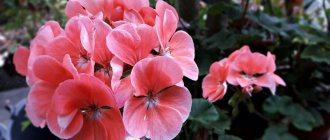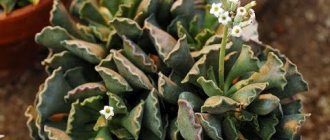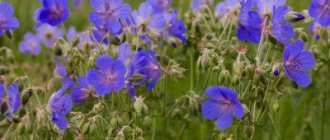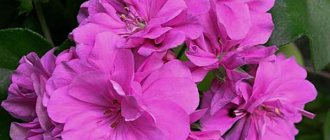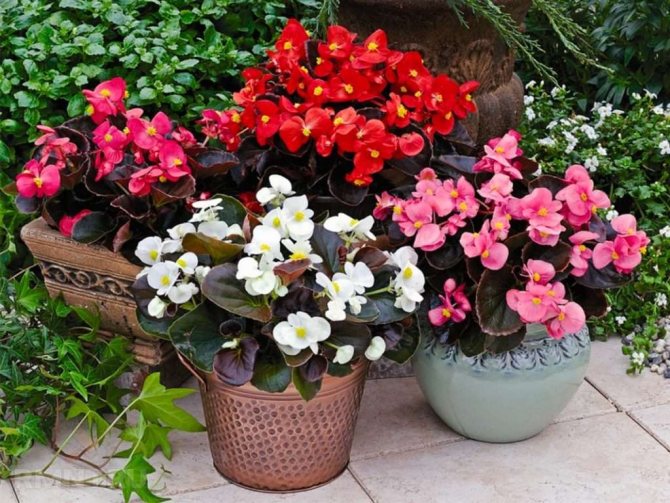
Begonia (Begonia) belongs to the most famous and numerous genus of the family of the same name. This genus unites about 1 thousand species of various plants, which in natural conditions can be found in the mountains, and they prefer to grow at an altitude of 3-4 thousand. meters above sea level, they are also common in tropical rainforests and subtropics. In this article we will consider the types of room begonias and photos with names.
Among begonias, there are annual and perennial grasses, shrubs (occasionally climbing) or semi-shrubs with a creeping or tuberous-thickened rhizome, sometimes with a tuber. Leaves are usually asymmetrical, often beautifully colored (especially in cultivated species). Flowers are irregular, mostly unisexual, monoecious. Tepals are unequal, brightly colored; the fruit is a box.
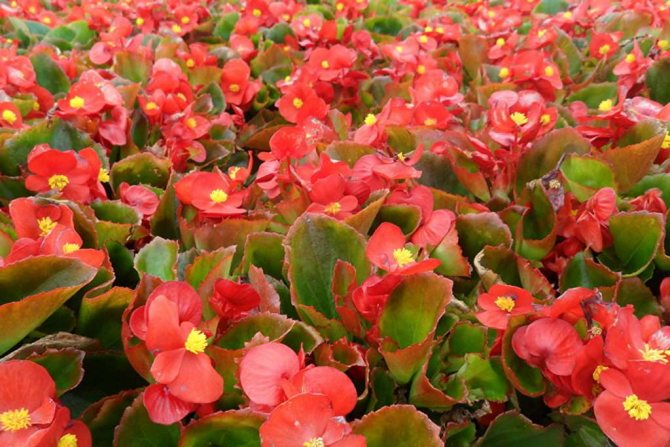

A well-developed root system of begonia is branched, fibrous or tuberous. Begonia, which has a root in the form of tubers, can be grown not only indoors, but also in the garden. Other types of begonias are grown only at home.
The Antilles are considered the birthplace of begonias. The plant was discovered there at the end of the 16th century by members of one of the scientific expeditions organized by Michel Begon. Subsequently, plants unknown at that time, found and described by the botanist from France Charles Plumier, who also participated in this trip, were named after him.
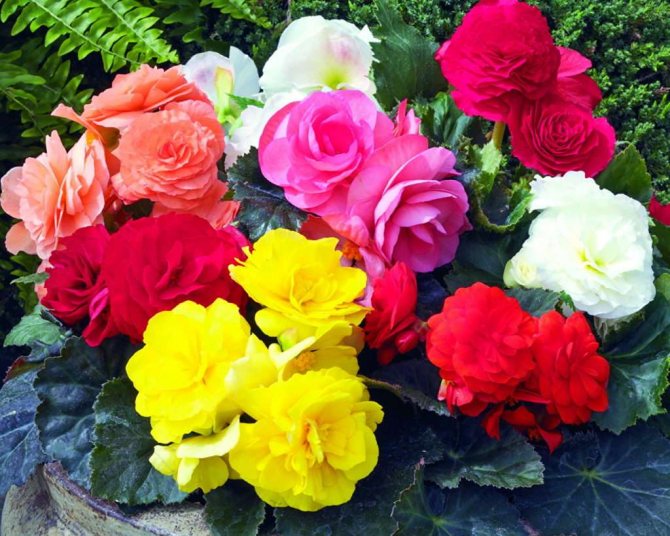

Today, there are a lot of hybrid forms of begonias in the modern form of floristry. Depending on the decorative qualities, there are decorative-deciduous and decorative-flowering varieties. There is another classification, according to which the varieties of the incredible flower are divided into three categories:
- leafy (propagation by roots);
- bush (propagated by seeds and apical shoots);
- tuberous (bred with tubers).
Description of the plant
All plants, native to tropical forests, are quite difficult to care for. Requires special care for begonia at home in a pot: following the rules for lighting, watering. Due to the characteristic color of the leaves, conventional fertilizers are not suitable for begonias.
Among the species that are grown indoors, decorative deciduous and flowering ones can be distinguished. The former are distinguished by a bright large leaf plate. The second - lush flowering. In addition to the usual plants of this species, there are many hybrid varieties created by the method of selection. Flowering species are sometimes planted in open ground to gain strength and nutrients, then transplanted back into pots in the fall.
The following signs are characteristic of begonias:
- asymmetry of the leaves;
- the brightness of the sheet plate;
- small size of the bush.
Flowers can be ordinary and double, different in color and size of the peduncle.
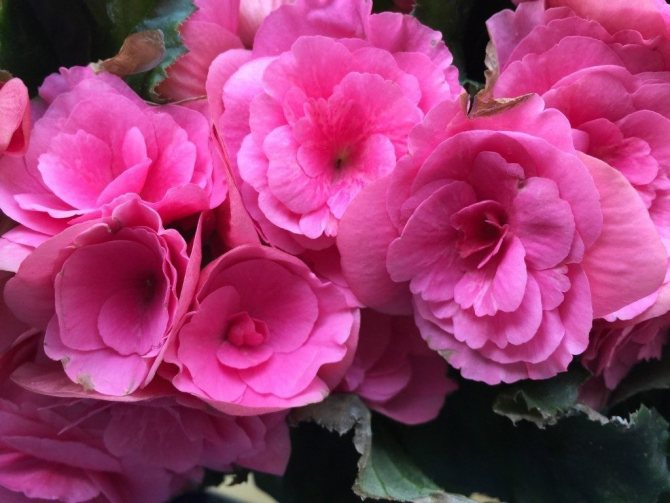

Perennial begonias are most commonly grown in the room, although there are annuals sown annually. After the end of flowering, a box with seeds is formed, which can be collected and propagated.
The root system of a flower, depending on the species, is tuberous, branched, with lateral horizontal processes. A pot is chosen according to the type of roots - it must be wide so that the plant feels comfortable.
Top dressing
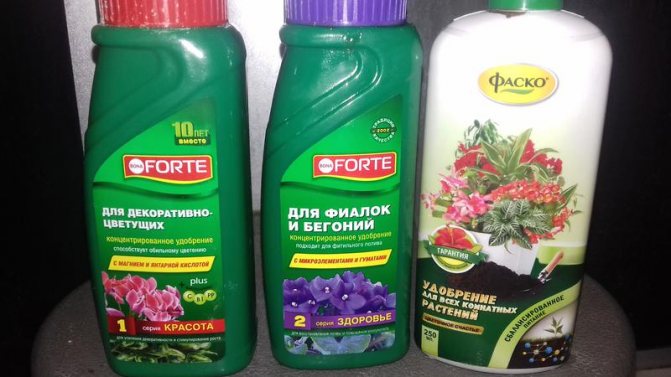

Begonia feed
The first feeding should be done when the first buds appear on the plant. So the flowering will be more lush and long.
However, fertilization must be done with caution. It is best to use complex products with a low concentration of nutrients. Top dressing is carried out regularly until the end of flowering.
IMPORTANT! Blooming begonias should not be fed with fertilizers with a high nitrogen content due to the fact that the plant will shed its buds.
Deciduous varieties for home cultivation
Indoor begonias with beautiful bright leaves are most often tuberous. They grow poorly among other plants - they prefer their own neighborhood. For good growth, you need to place begonia flowers at a distance from each other.
Tiger (Bauer)
The variety got its name because of the color of the leaves in green, brown and light tone, reminiscent of the pattern on the skin of a tiger.
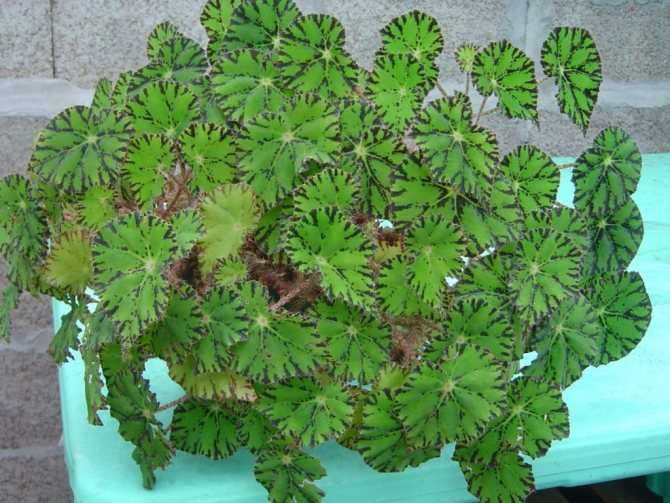

Silver greenhart
Leaves with a silvery tint, a dark border with light specks runs along the edge.
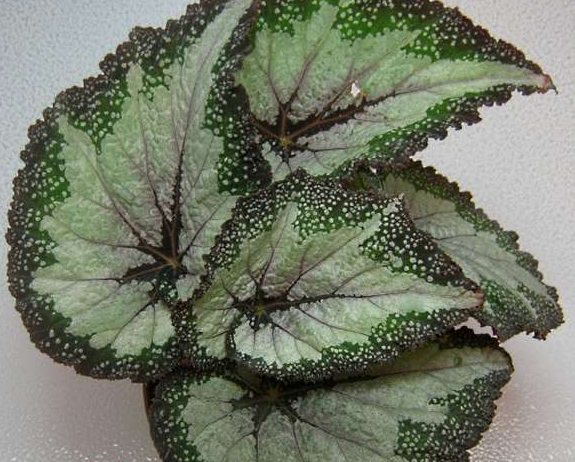

Evening Glow
There are several varieties, a distinctive feature of all is blotches of burgundy color.
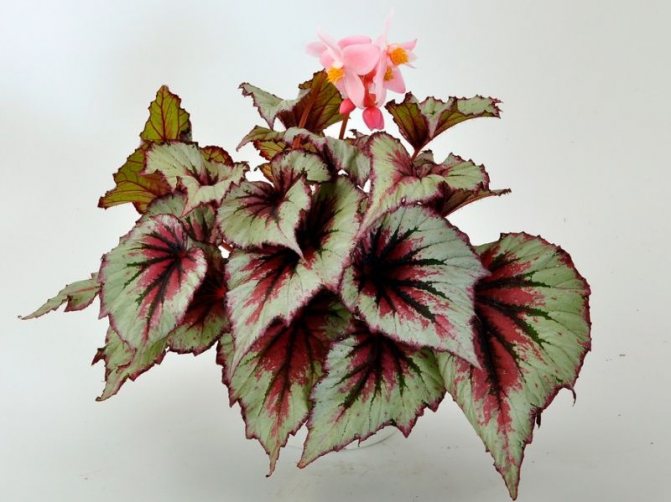

Cartagena
The leaves are rolled up in a spiral, which is emphasized by a silvery pattern. Another color option is a dark leaf plate with silvery spots.
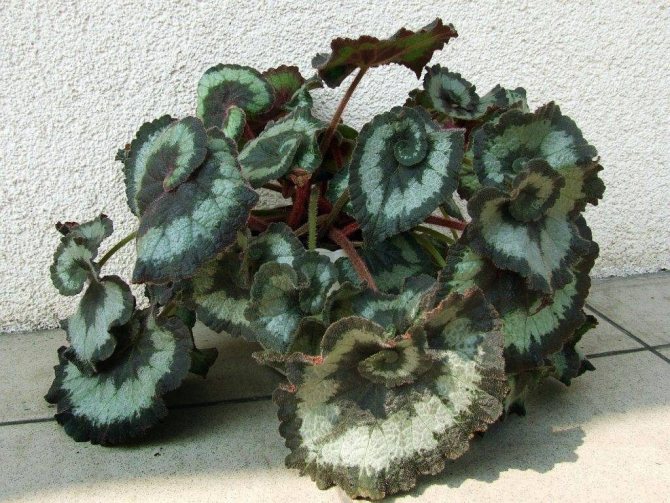

Chocolate cream
The dark middle of the leaf is the color of a ripe plum, the rest of the background is light.
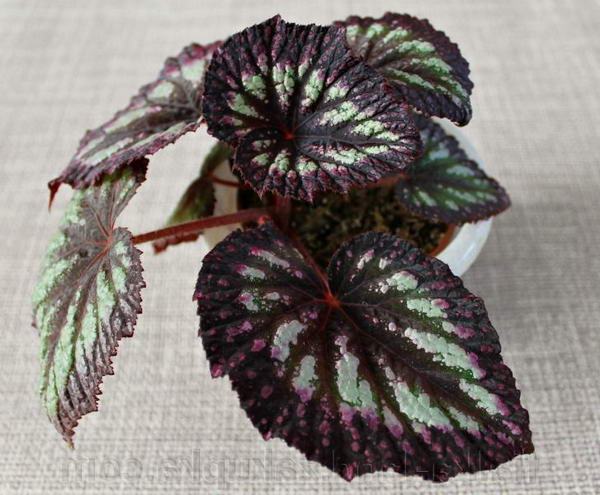

Hallelujah
Large-leaved indoor begonia with purple leaves, cherry-colored edging and a green stripe in a circle.
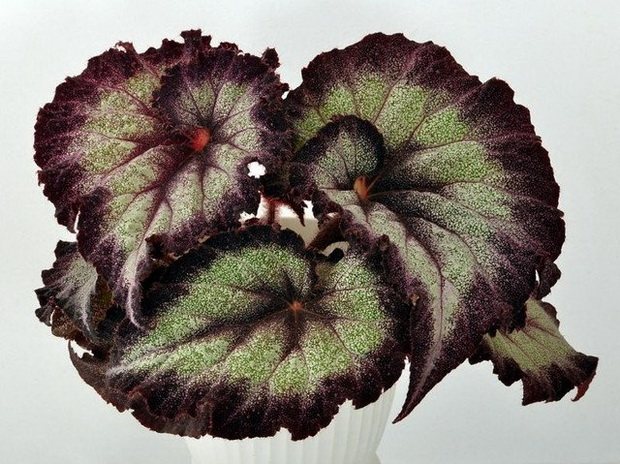

Cleopatra is a species of tiger
The leaves look like maple leaves. The stems are purple-red. In winter, it blooms with small pink flowers.
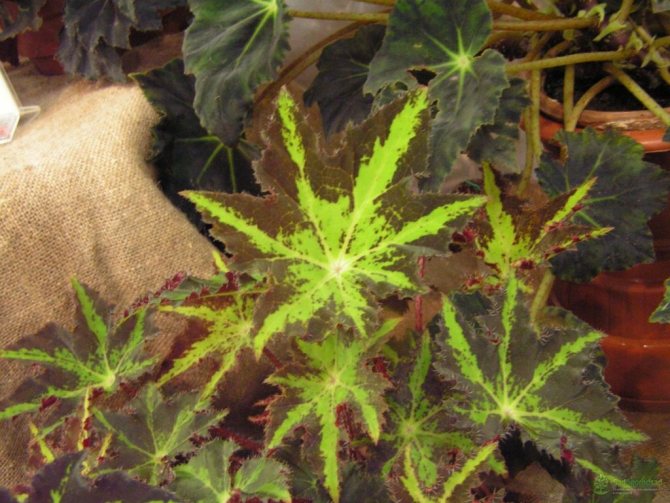

Hogweed
Leaves are gray-green with a bright green center. In shape, the leaf plate resembles a hogweed plant.
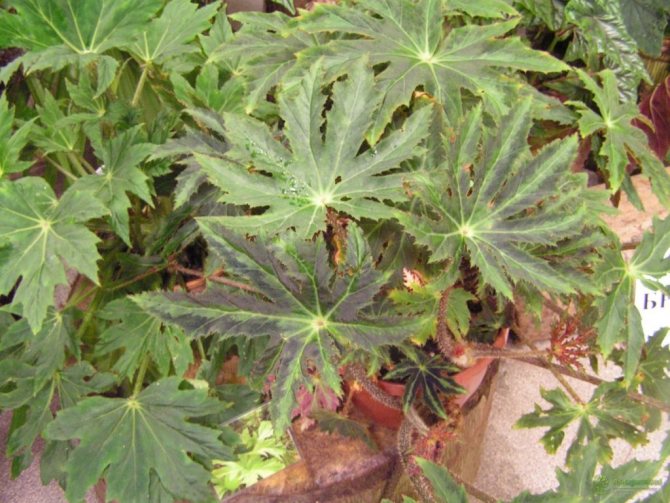

Red-leaved begonia
Unlike previous species with fluffy leaves, red-leaved begonia has smooth, glossy leaf plates.
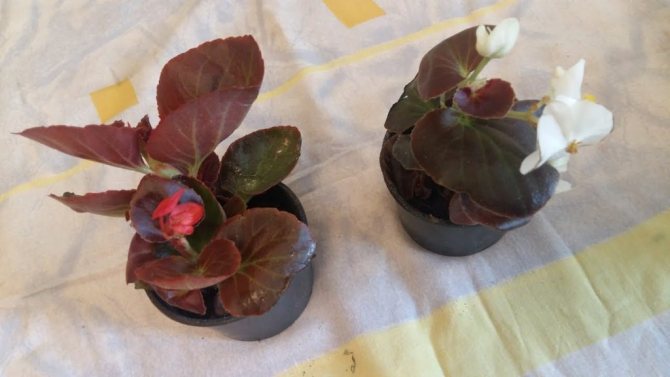

Appearance
ATTENTION: There are no less than 900 species and varieties of begonia in total! One of them is naked begonia. The name of bare begonia is no coincidence: this flower has long creeping bare stems, they seem to creep along the supporting trees, sometimes the stems grow up to four meters.
The leaves of the naked begonia are long (up to 9 cm), wide (about 7 cm), shaped like an egg - smooth, shiny, slightly pointed towards the top and flat at the base. Castings are based on short cuttings, no more than 2 cm. The leaves grow in the same plane, on one side and the other of the stem.
Begonia flowers naked white, small, collected in peculiar clusters - inflorescences... They decorate, like a delicate white or white-pink monisto, rock gorges, tree trunks covered with moss. And interestingly, male flowers have 4 petals, and female flowers have 5.
In our area, begonia is unpretentious, easily adaptable, adaptable to the habitat and the local climate. Begonia likes to settle down somewhere in the crevices of rocks or on old trees, roots. The main thing is shaded places, rainforests saturated with moisture. Begonia does not tolerate the burning scorching sun.
Blooming begonias
Decorative flowering begonias are valued for the brightness of their peduncles. Their foliage is of normal color, not very attractive.
Carmen
The variety cannot be confused with other species: the leaves are dark cherry color. It blooms with pale pink peduncles.
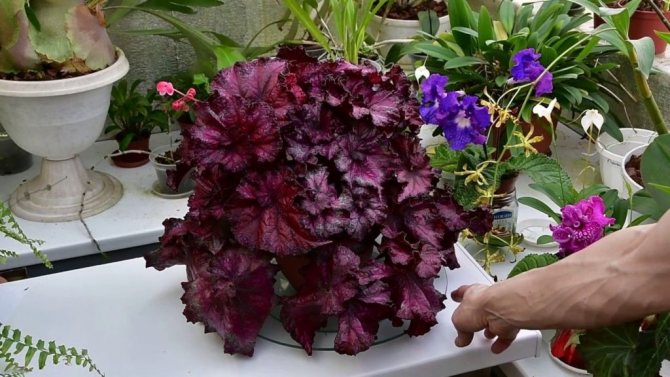

Caroline
The leaves are dark green, not very attractive, but the bush is strewn with bright pink flowers that stand out against the greenery.
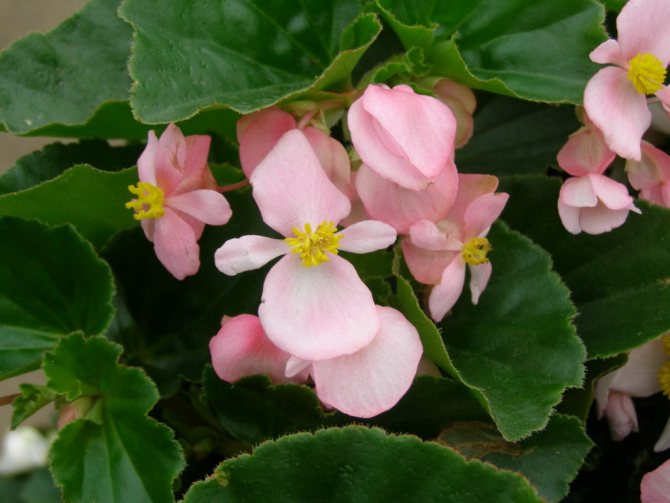

Ambergris
The buds are light pink, the leaves are brown, glossy.
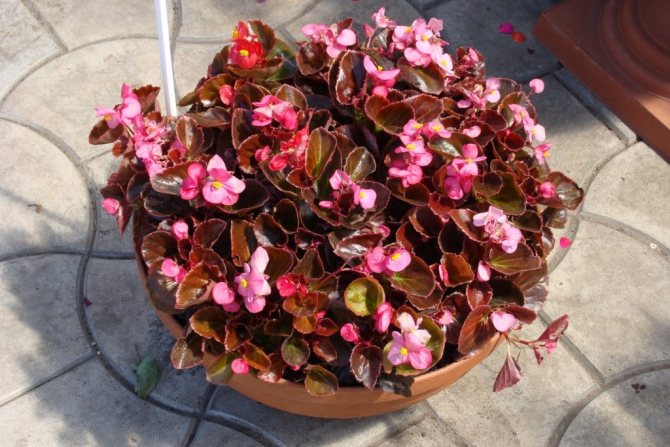

Fimbriata
Forms double bright yellow peduncles against the background of ordinary green leaves.
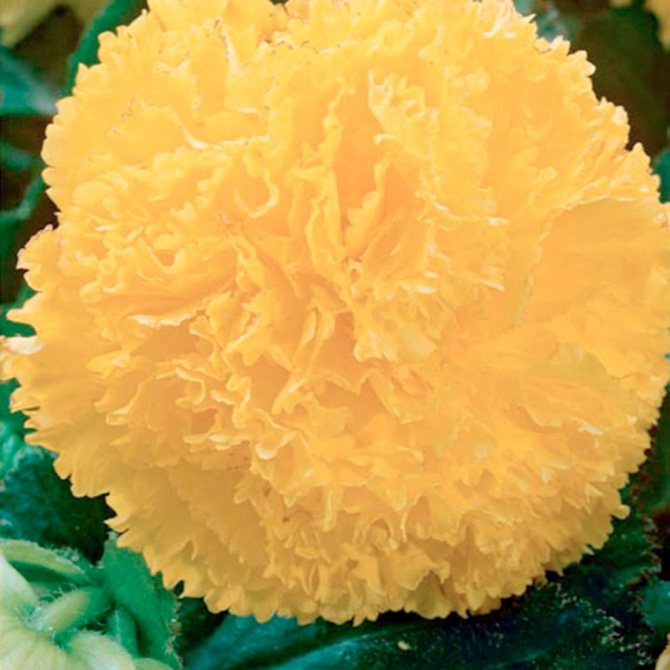

Bicol
Not the brightest variety: glossy small leaves with white flowers, casting a pink tint.
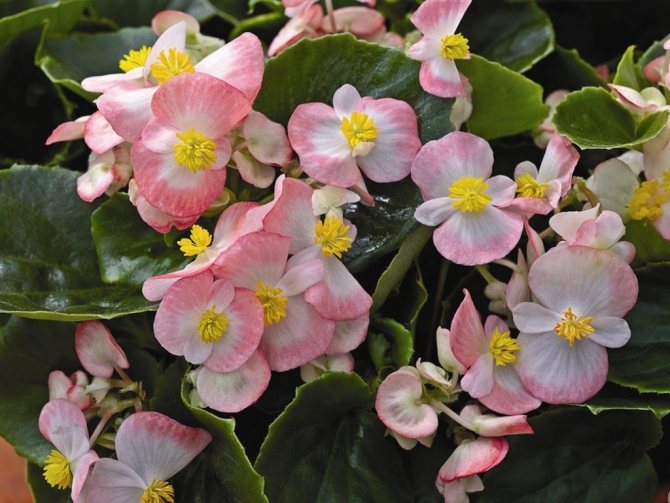

Elatior
A variety that blooms in various shades of pink. Terry flower stalks, similar to rose flowers. Begonia Elatior blooms magnificently and forms a large number of buds at the same time.
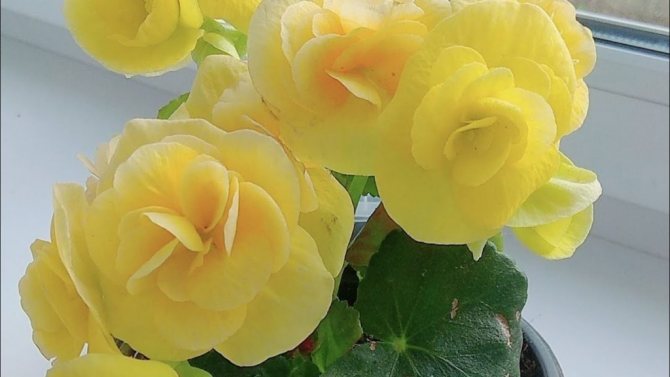

Begonia ampelous
One of the most attractive indoor varieties. Peduncles of different shades - double and ordinary, located on long shoots, so it is better to hang them in a pot.
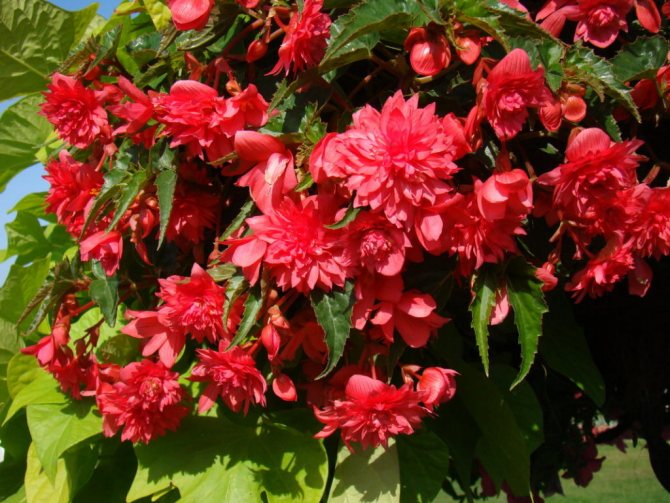

Answers to popular questions
Begonia stopped blooming, what happened?
Most likely, you are feeding the flower incorrectly or irregularly. For a lush and long-lasting flowering, the plant needs to receive nutrients regularly.
Begonia's leaves turned yellow (turned pale), what should I do?
The color change of the leaf plates is related to the amount of light and temperature. Make sure the flower pot is not in the shade in a too cool place.
Strange spots of white (gray) color appeared on begonia leaves, what is it?
Begonia leaves become stained (shiny and sticky) due to diseases or pests. If you notice such changes, then the plant should be quarantined and treated with bactericidal and insecticidal agents, a solution of laundry soap or ash.
How to care
Beginner rules on how to care for begonia at home in a pot, include the following requirements:
- watering and air humidity control;
- fertilization depending on the growing season and plant variety;
- light - the choice of a window and the organization of additional lighting in winter;
- transplanting as the roots grow.
In the process of caring for a begonia in a pot, there can be mistakes, since gardeners first decide to have a beautiful plant, then they begin to study the needs. During this time, the flower has time to get sick, sometimes it stops blooming.
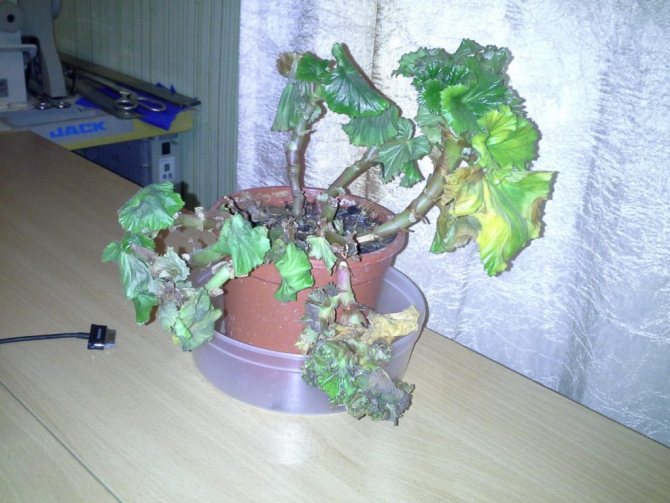

Watering
The degree of watering is adjusted so that the earthen lump is always moist, but the roots at the bottom of the pot are not constantly in the water - it is drained from the pan. In summer humidity 70% can be maintained by spraying indoor air or household spray. In winter, plants are usually found on the windowsills, under which the batteries are located. How to water begonia at home to enhance evaporation:
- Find another pallet - a larger one.
- The first one is turned over and placed in a larger pot on it.
- The remaining space is covered with expanded clay and filled with water.
It is necessary to maintain humidity in expanded clay - it will give off water in the form of fumes. The earth lump is moistened as needed, expanded clay - daily.
Important! Do not spray deciduous begonia over the leaf. This can cause brown spots.
Top dressing
Fertilizers for decorative flowering and deciduous varieties are different. Potassium and phosphorus are needed in large quantities first. Start feeding before flowering to get more buds. Nitrogen is applied in minimal amounts and only in spring. If you overdo it with nitrogen fertilizing, the plant will not bloom, but will grow leaves and shoots.
Deciduous species, on the other hand, need nitrogen fertilization to form lush greenery. Nitrogen can be fed twice a month throughout the growing season.
Lighting
Begonia leaves are very delicate, especially deciduous varieties. Direct exposure to sunlight can severely damage them, so the plant on the windowsill should be shaded if the afternoon sun is shining on them. Morning rays are useful - their intensity is low. In winter, look for the most brightly lit window, as many species bloom in winter.
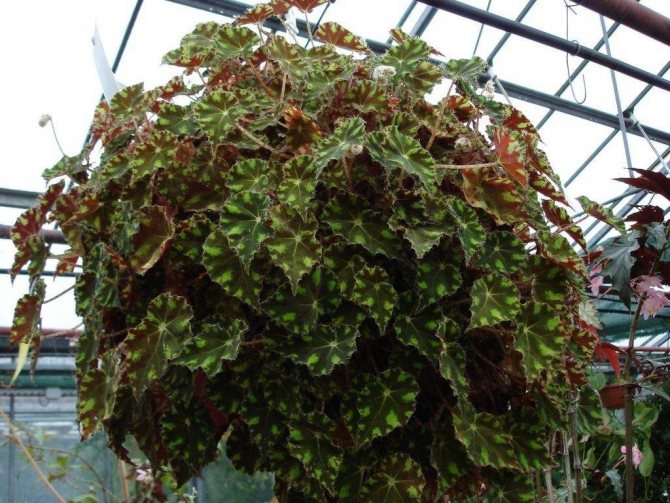

The air temperature in summer should be in the range of 21 - 23 degrees. In winter, it is slightly reduced up to 15 - 18.
Transfer
Transplanting begonias is an important condition for growth and flowering. It is carried out as the root system develops. If the pot is small, the roots will protrude from the bottom.Tuberous deciduous can stop the growth of new leaf plates. This is due to the depletion of the soil in the pot, as organic matter runs out and soil microorganisms die.
How to transplant begonia at home step by step:
- Prepare a larger pot 3 - 4 cm compared to the previous one.
- Put expanded clay or coarse sand at the bottom. Small stones are suitable, which must be pre-washed and calcined in the oven for disinfection.
- Fill the pot halfway with soil.
- Remove the plant from the old pot, rinse the roots in potassium permanganate. If there are rotten areas, remove. Dry the rhizome.
- Place in a new pot and cover with soil.
Begonia after buying and transplanting at home needs to be adapted. To do this, it is temporarily removed in partial shade to get used to the new soil. It takes 3-4 weeks, then the plant returns to its place.
Frequent mistakes
- Watering too often... A large amount of water leads to root rot and death of the flower.
- Bad soil... Begonias need loose soil. Otherwise, the roots will not "breathe" and the water will stagnate.
- Insufficient or irregular feeding... With an insufficient amount of minerals, begonia stops blooming.
- The required air humidity is not provided... Aridity causes foliage to dry out.
- The temperature regime is not observed... From the cold, as well as from the scorching heat, begonia can die.
How to choose a flower in a store, what to look for
In order not to have to treat all houseplants, begonias in the store should be examined for pests and diseases. What to look for:
- Whether there are dark or dry spots, indicating a fungal disease.
- Damage to sheet plates due to careless handling. Such leaves will dry up and fall off anyway.
- Are there any crawling insects or a thin web, which indicates a spider mite infestation?
After purchase, the plant is immediately transplanted into nutrient soil, since before that it was in transport. It is recommended to move the flower away from others for a couple of weeks. In case of an unnoticed infection, you will not have to treat everything.
Video: Begonia - care secrets
Content
- 1. Description 1.1. Popular varieties and varieties
The genus Begonia is represented by the Begoniaceae family. It includes 1,700 varieties of herbaceous annuals and perennials, dwarf shrubs and lianas. Among them there are lithophytes growing among stones, as well as epiphytes that prefer to settle on other plants.
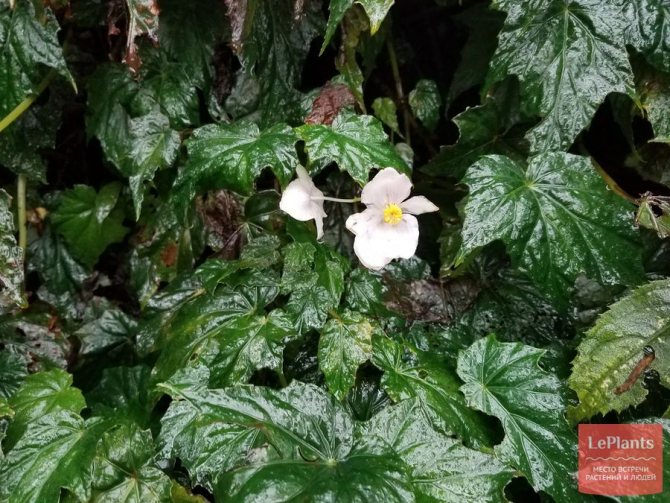

PHOTO: Blooming wild Begonia from Yangmingshan National Park (Taipei, Taiwan).
Wild-growing Begonias are found in the subtropical and tropical zones of Southeast Asia, Africa, South America, New Guinea, Sumatra, and the Philippines. First brought from the West Indies, Begonia was domesticated on the island of San Domingo, now Haiti, in 1690. The discoverer of the genus was the French biologist Charles Plumier.
Begonia is named after the quartermaster of the French colonies and, concurrently, plant researcher Michel Begon.
Today Begonias are grown as decorative leafy and flowering indoor plants. In areas with mild climatic conditions, they adorn flower beds and front gardens, pleasing the eye with flowering from late spring to early autumn.
Reproduction
If a large indoor begonia has grown, home care includes its reproduction. This can be done in several ways. The plant is distinguished by its vitality and sprouts in any case.
Cuttings
The easiest way. To do this, cut off the stalk on which there is 3-4 sheets.
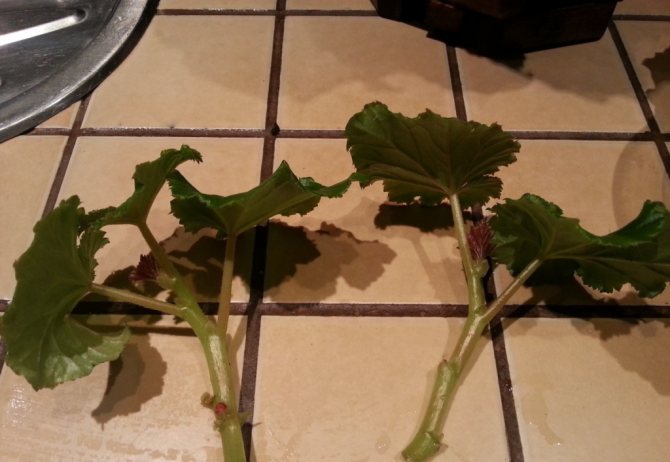

The cut is treated with a fungicide or charcoal. The workpiece is placed in a glass of soft water or immediately immersed in a peat substrate. The roots germinate after a month.Next, the begonia is transplanted according to all the rules in a small pot corresponding to the size of the roots.
All the time, the flower should be in partial shade, away from direct sunlight. Watering as needed when the topsoil dries out by 1.5 cm.
Leaves
For this method, a whole sheet or part of it is suitable.
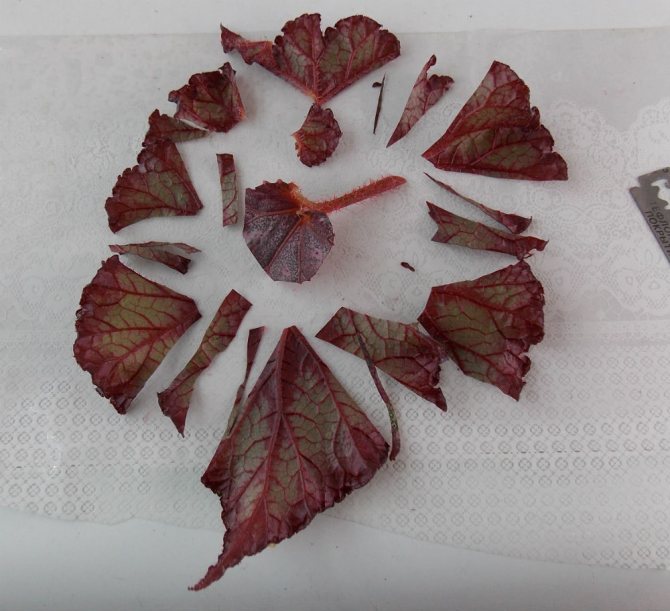

To grow begonia from a leaf, you must:
- Cut veins on the underside in several places.
- Lay the sheet with cuts on wet, clean sand.
- Fix the sheet so that it begins to dry and curl.
- Water the sand around the leaf as it dries.
After a month, approximately in the lower part, roots will begin to form, and then small leaves-sprouts will appear. When they increase slightly in size, they can be dived and planted in the ground.
By dividing the bush
Divide the root or tuber into several parts with a sharp knife. In this case, kidneys and roots should remain on each section. Places of cuts should dry completely before planting, then they are sprinkled with crushed charcoal for disinfection and planted in separate containers.
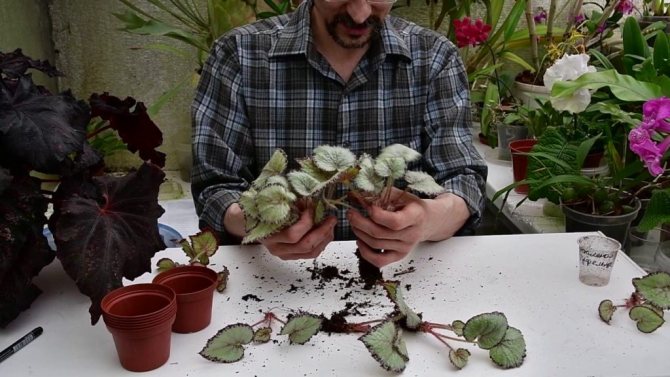

Seeds
How to grow begonia from seeds:
- Prepare a container with a moist substrate.
- Spread the seeds over the surface, but do not sprinkle with soil.
- Cover with foil or glass to prevent moisture from evaporating quickly.
- Wait for the sprouts to appear, periodically spraying the seeds with a spray bottle.
- When are formed 3 - 4 sheets, seedlings dive, and 2 months later transferred into small individual pots.
Unlike other plants, seed-propagated begonia begins to bloom in the first year, but the sprouts need to provide good lighting to gain green mass.
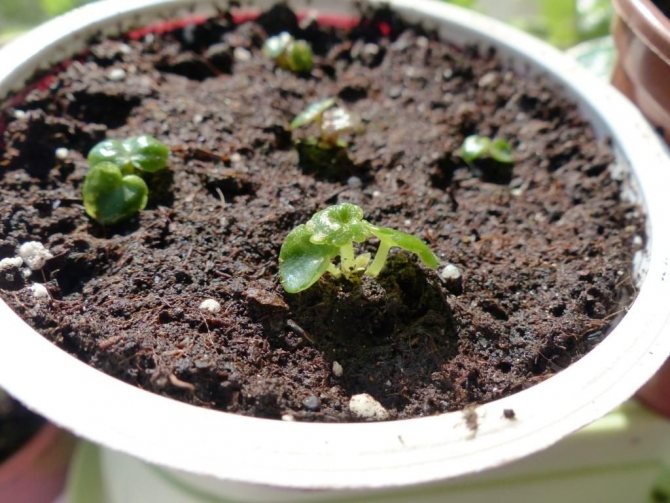

Rejuvenation
Correct flower pruning is the key to rejuvenating your pet.
After cutting, the cut sites must be treated with ash or crushed activated carbon. It is also necessary to reduce the frequency and abundance of watering. After the side shoots grow to about 10 cm, they are pinched. Then cut out old and dried out shoots, as well as leaves.
IMPORTANT! Pruning begonias should be done with a sharp clerical knife. In this case, the cut will be neat. Scissors or a dull knife will damage plant tissue, which can lead to disease.
Doing these pruning and pinching every year rejuvenates the begonia and keeps it looking good for years.
Begonia diseases
At first, beginners in the cultivation of begonias are faced with fungal diseases. This is due to improper watering: insufficient or excessive. In the first case, the plant becomes ill due to dehydration, in the second, due to high humidity and rotting of the roots. Signs of fungus in begonias:
- the root neck turns black;
- leaves soften, covered with gray or white bloom;
- leaves turn yellow, become watery.
For the treatment of the fungus, fungicidal preparations are used to spray the plant and soil.
Viral diseases of begonias cannot be cured. This is a cucumber mosaic, tomato spotting. If such symptoms appear, the plant must be urgently destroyed.
Drying of leaves is most often associated with increased dryness of the air. In this case, you need to put containers with water around the plant for evaporation, moisten the earthen ball and reduce the air temperature. up to 16 - 18 degrees.
If the begonia freezes, its leaves will turn yellow and wither. The plant needs to be warmed, moved to a warm place, and watering should be reduced. In the cold, roots that are overly flooded with water will begin to rot and the culture will die. Another reason is watering with cold water during the warm season. The delicate root system does not tolerate temperature extremes.
In flowering plants, yellowing can be associated with complete depletion of the soil and chlorosis.It occurs closer to flowering, when begonia draws the last minerals from the soil to form buds.
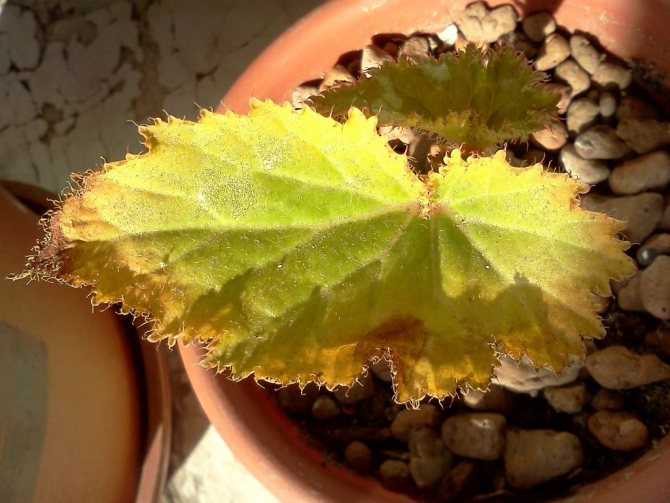

The culture is urgently fed, preferably with a liquid complex solution, otherwise the plant's immunity will fall, and it will drop the buds.
Diseases and pests
Begonia should be protected from pathogens of annular and bacterial spot, powdery mildew, gray rot. For the prevention and treatment of such diseases, fungicides are used: Topaz, Fundazol, Fitolavin, Alirin-B, Abiga-Peak.
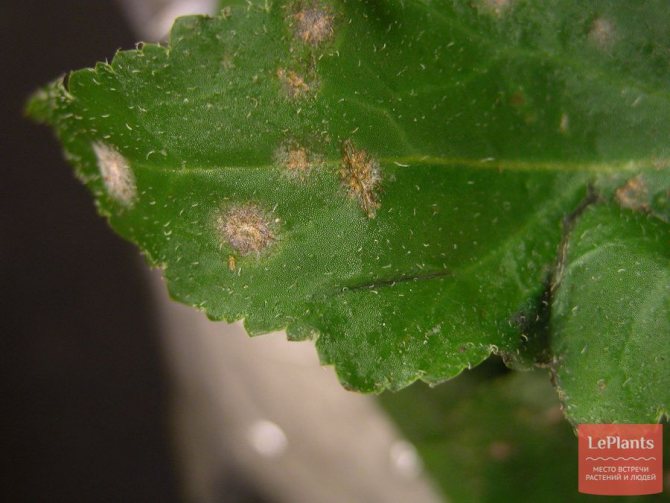

ON THE PICTURE: Powdery mildew on the Begonia leaf.
When the air is dry, Begonias are affected by spider mites. To expel ticks, the acaricides Karate, Aktara, Aktellik, Vermitek are used.
On Begonias, greenhouse aphids, whiteflies, false shields, thrips are found. To get rid of insects will help the preparations described in the material: "Insecticides: help in the fight against pests."
Temperature
Begonia is very demanding on the room temperature. She does not tolerate extreme heat well.
Comfortable for her is the temperature range from 20 to 24 ° C. In winter, for this thermophilic plant, you need to maintain a temperature of at least 15 ° C.
An increase in air temperature to 30 ° C and above leads to a strong slowdown in growth and lack of flowering. A decrease in temperature below 15 ° C also affects begonia. Temperatures below 5 ° C lead to damage to the leaves of the plant and their death.
Tuberous begonias require cold wintering. Their tubers are dug up and stored in a dark room at a temperature of 5-7 ° C. After the end of the dormant period, they are germinated in spring. In this case, it is necessary to maintain a temperature of about 18 ° C.
In summer, begonias are grown on open balconies and loggias. With the onset of warm weather, they are taken out into the open air during the day, and taken to the room at night. They are finally taken out to the loggia when the night temperature is at least 15 ° C.
Mason or Maltese Cross (Masoniana)
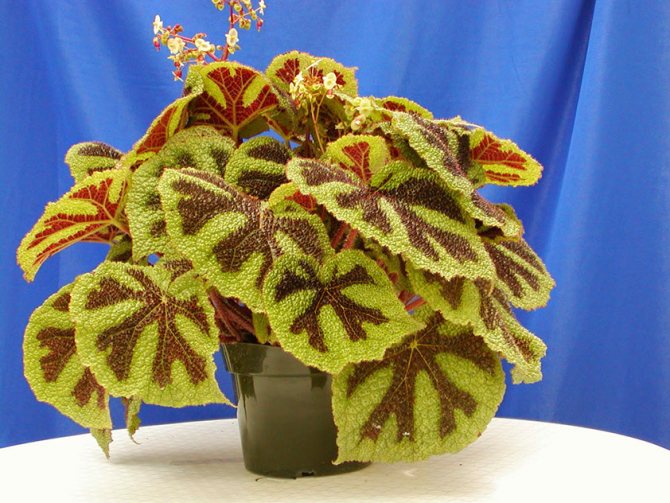

Begonia "Mason"
This is an amazingly beautiful kind of indoor begonia. The bush is compact, effective. The roots are creeping, thickened and pubescent with numerous hairs. Bumpy begonia leaves are rounded-angular, asymmetrical, light green in color. In the center of each sheet, a crimson design is drawn, reminiscent of a five-fingered Maltese cross. With age, the general background of the leaves becomes silvery.
Transfer
A capricious begonia does not tolerate a transplant, so this is done only when it has outgrown an old pot.
If roots decay, begonia should be transplanted immediatelyby clearing the root system of old soil and removing all rotten parts.
Healthy plants, so as not to injure the root system, are transplanted by transshipment in April or early May.
The pot is taken larger than the previous one by 1-1.5 cm in diameter... Tall pots should not be taken, because natural ventilation of the soil is difficult in them.
The drainage layer must be made at least 3 cm thick from broken brick or expanded clay. The plant is very carefully removed from the old pot, set in a new one, and fresh earth is poured around the edges.
Red-leaved (Erythrophylla or Feastii)
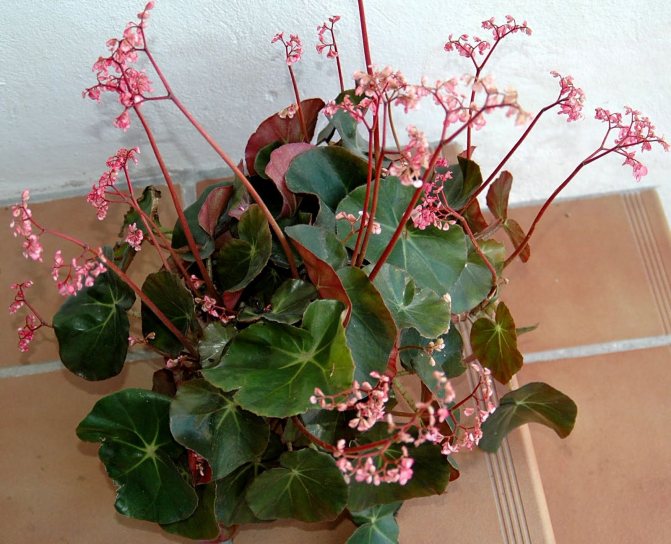

Begonia Red-leaved
This plant has another name for flower growers - "Fista". It has a slightly shortened stem, erect, with nodules. Long cuttings and round leaves whole or cut into several segments, the surface of which is dense, smooth, almost glossy. The front side of the leaves is green, and the back is red, brownish or purple with well-traced white veins. The edge of the leaf is serrated or wavy. Flowering occurs from December until the onset of spring. The color of the flowers is white, pink, yellow, red with frames of various shades.
Tuberose (caudex) (Semituberous)
Caudex, caudiform begonias (Caudiciform Begonias) are often combined in a group with tuberous. In this case, you can meet under the name of the group: Tuberous / Semituberous, or Tuberous and semituberous begonias.
Caudex have no tuber, but there is a special shape of the stem - "caudex" (trunk). They grow seasonally when there is plenty of natural light and should be treated like succulents. The caudex thickening of the main trunk in these begonias is at the soil level (above) or below.
Caudiform species are often called "maple leaf begonias" - maple-leaved begonias ...
Begonias: 'partita' and 'dregei' resemble miniature trees. In the photo: B. ‘dregei’ ...
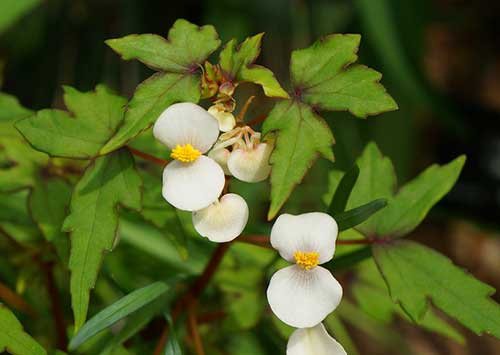

B. ‘dregei’ - leaves are small, similar to maple, stems are red. It blooms in abundance with white flowers. The ‘partita’ leaves are more dissected, asymmetrical.
From caudiform begonias for the home, we can recommend the following forms and varieties: ‘cinnabarina’ (with orange flowers), ‘suffruticosa’, ‘richardsiana,‘ rubra ’,‘ dregei ’,‘ partita ’...
Humidity
A very significant requirement for the cultivation of a tropical beauty is good air and soil moisture.
Attention: it is not permissible to spray the crown with a spray bottle from above - this causes the appearance of brown spots on the leaves.
To achieve a certain humidity, there are some tricks with the pallet. You can fill it with a layer of expanded clay and fill it up to half with water, or you can use a hydrogel, but the main thing is that the bottom of the pot itself is not in the water. Then moisture, so important in a dry room, will come from below directly around the flower.
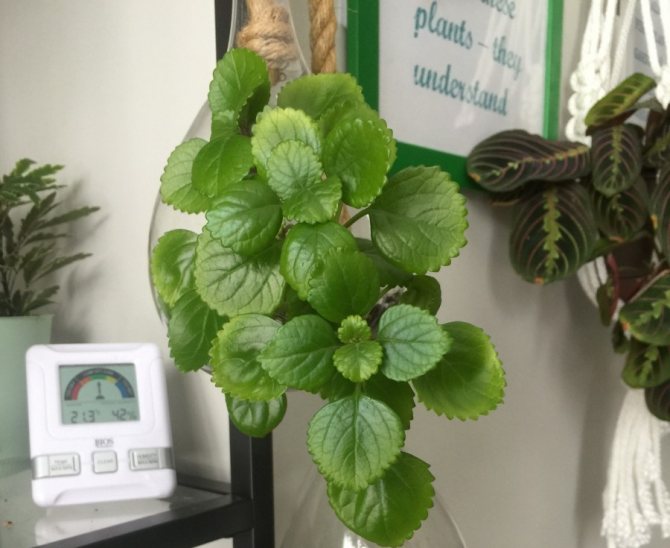

Bindweed (Convolvulacea)
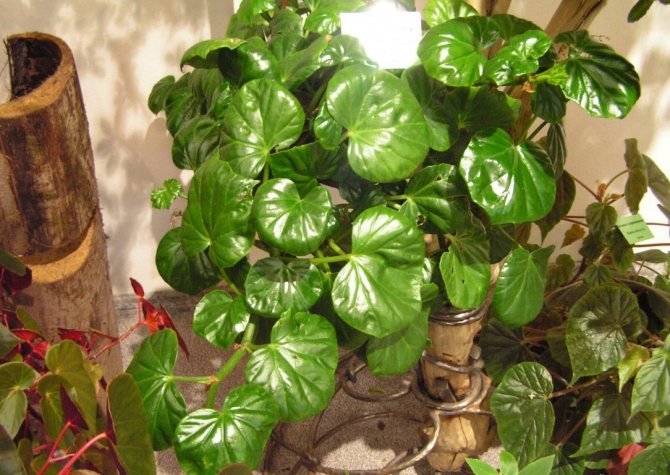

Begonia "Bindweed"
Such begonias seem to be created for arches, all kinds of openings and ladders. As a support, you can also use balcony grates, which in one summer season will turn into delightful flower walls, delighting the eyes of the owners and passers-by on the street.
However, climbing begonias are afraid of direct sunlight, so they should be placed on the northeast or northwest side of the house, or in the shade of other plants. The leaves form a lush bush with a height of about 20-30 cm, although while maintaining comfortable living conditions, the plant can grow up to 50 cm. The flowers are small, expressionless.
Features of the
Do not carry begonias from place to place.
In order for this demanding plant to bloom and grow well, you need to know some of the features of caring for it.
Begonia likes stable conditions, and does not tolerate their change. Even moving it to another room is not recommended in order to avoid illness or even death.
Drafts can be fatal to begonias... Therefore, the pot with this flower should be installed where the air movement will be minimal, and when airing the room, cover the plant.
Ornamental deciduous species can thrive throughout the year, while flowering varieties need a dormant period. At this time, watering is reduced, and tuberous varieties are not watered at all.
The soil
For the active growth of begonias, a fertile and at the same time light earthy mixture is required. It must pass moisture well so that the water does not stagnate.
The optimal composition of the soil mixture is: 2 parts of leafy soil, peat, humus and very coarse river sand - 1 part each.
Baking powder can be used instead of sand.: vermiculite or perlite. These additives prevent soil caking.
You can also buy suitable soil for begonias at a flower shop. You need to take a universal soil mixture with the addition of peat.
Classification
It is not easy for a novice florist to understand the complex "kinship" ties of the begonia family, especially since there is no single, generally accepted classification of plants. Based on the appearance of begonias, features of use in floriculture, the following types are distinguished.
- decorative deciduous indoor;
- decorative and flowering indoor;
- decorative and flowering garden.
The European classification is based on the mode of reproduction and general biological characteristics. There are 9 groups of plants, the most famous of which are:
- Caine begonias and shrubs are reed or bushy, with an erect stem, beautiful leaves, fragrant flowers. They can grow up to 2 m in height. The vivid representatives of the species are spotted and coral begonia.
- Royal and rhizome (rhizome) are herbaceous species with a thick fleshy stem, openwork multi-colored leaves, a creeping rhizome - the main organ of vegetative propagation.
- Ever-flowering - small bushes with "waxy" leaves and bright flowers of all warm shades of the rainbow. Cultivated as an annual garden plant.
- Tuberose or tuberous is an unpretentious flowering form with large double flowers. There are ampelous varieties.
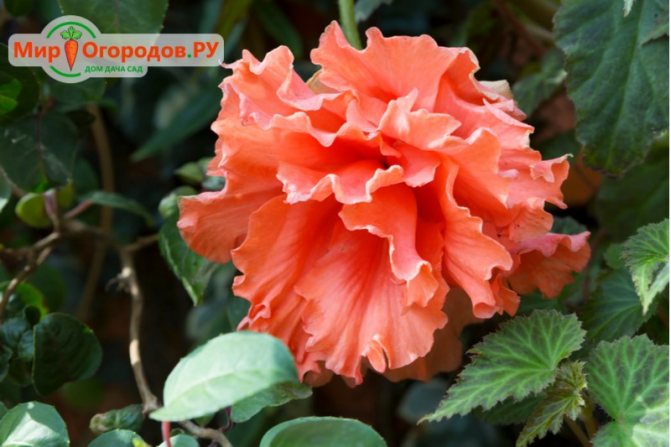

Problems
Sometimes, due to improper care, the plant loses its decorative effect, which signals the beginning of problems. In this case, errors must be eliminated as soon as possible, because begonia is very capricious and often dies even with the slightest errors in care.
If brown spots have formed on the leaves of the plant and the flowers have darkened, this indicates the ingress of water. It is necessary to reduce the humidity in the room, and in the future it is more careful to water and spray the plant.
Lack of moisture causes leaves and buds to fall off... And if the leaves curl and dry up, this is a sign of a pest attack.
When the plant hits the sun, burns in the form of light dry spots are inevitable. With a lack of lighting, the color of the leaves turns pale, the plant does not bloom.

